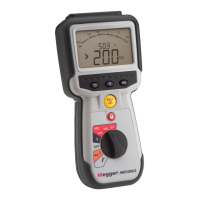41
15. Battery and fuse replacement
15.1 Battery condition and replacement
The battery condition indicator is displayed at all times that the instrument is switched on, as below: 100%, 75%, 50%, 25% and
low, as below:
100% 75% 50% 25% Low
Replacement battery types are:
6 x LR6 (AA), 1.5 V Alkaline,
or 6 x 1.2 V NiMH
WARNING: Do NOT use AA size LiON (Lithium Ion) rechargeable cells as these are 3.4 V each and could permanently
damage the instrument.
Note: NiMH rechargeable batteries show a lower charge than Alkaline batteries, and may not give much warning before becoming
exhausted.
15.2 Procedure to replace batteries:
1. Switch off the instrument and disconnect the instrument from any electrical circuits.
2. Disconnect all test leads from the instrument.
3. To remove the rear cover, undo the screw on the rear of the battery cover, lift the cover off.
4. Remove the dead cells and refit new batteries, observing the correct polarity as marked on the battery compartment.
5. Replace the cover and retaining screw.
6. Dispose of the cells appropriately.
Warning: - Incorrect battery cell polarity can cause electrolyte leakage and damage to the instrument. If the battery
condition indicator does not show a full charge, a cell may be reversed.
Charging with a reversed cell can cause localised heating and possible damage to the case.
Battery cells should not be left in an instrument which may remain unused for an extended period.
15.2.1 Battery Voltage
Battery voltage should be changed to 1.2 V if NiMH are used. See Section 13 Setup.

